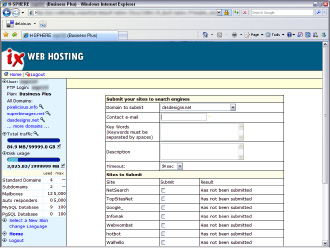Building Web Sites All-in-One For Dummies® (104 page)
Read Building Web Sites All-in-One For Dummies® Online
Authors: Claudia Snell

However, certain keywords and key phrases, such as
wedding photographer,
are in high demand. Therefore, the only way to ensure that your client's pay per click ad appears in a desirable position on the first or second results page is to allocate a large budget for pay per click advertising. When faced with a large pay per click advertising budget, your client will have to determine whether it's more economical to employ a top-notch SEO company or to sign up for the pay per click advertising campaign â or maybe both.
Submitting your site to search engines
After your client's site is optimized for search engines, it's time to submit the site to search engines. Some of them are highly specialized and might not be relevant to your client's type of business. There are so many search engines out there that you could go nuts trying to submit the site to multiple Web sites. Therefore, submit the site to the most popular search engines. Of course, what's popular now might be
passé
in two or three years. The following is a list of popular search engines and the URLs to the pages where you submit your site:
â¢
Google:
Google is considered the most popular search engine for the masses. You can submit a site to Google at
www.google.com/addurl/?continue=/addurl
â¢
MSN Search:
This is another popular search engine affiliated with MSN.com. You can submit your site to MSN Search at this URL:
http://search.msn.com/docs/submit.aspx
â¢
AltaVista:
AltaVista has been around for a while. It's a popular search engine that offers alternative services such as Yellow Pages, a directory, a shopping and travel section, a people-finder section, and much more. You can submit a site to AltaVista, which is powered by Yahoo! Search Technology. In order to submit a site, you must be a registered Yahoo! user. After you register as a Yahoo! user (it's free), you can submit a site at the following URL:
http://submit.search.yahoo.com/free/request
â¢
Yahoo!:
You can submit a site for inclusion in Yahoo!'s search engine at the same URL for which you submit a site to AltaVista. However, in order to guarantee that your site appears in Yahoo!'s search engine, you'll have to pay to submit the site, and then pay per click. You can find out more at this URL:
http://searchmarketing.yahoo.com/srchsb/sse.php?mkt=us
Many of the sites in the preceding list have specialized directories to which you can submit a site. However, a complete tutorial on submitting your site to search engines is beyond the scope of this book.
_fmt.jpeg) Don't resubmit your client's site to a search engine unless you made significant changes to the site or re-optimized pages using a different title or description, or you changed the keywords. Continually submit a site with no changes is considered
Don't resubmit your client's site to a search engine unless you made significant changes to the site or re-optimized pages using a different title or description, or you changed the keywords. Continually submit a site with no changes is considered
spamming the search engine
and can negatively affect the site's rank within the search engine.
You can find services that enable you to submit your site to multiple search engines for no fee by typing
free search engine submission
in your favorite search engine. However, many of these sites will try to sell you on using their paid services or will add you to some sort of mailing list. If you decide to use one of these services to submit your client's Web site, read the fine print.
Remember:
There are no free lunches.
Your Web hosting service might offer submission to search engines as part of their package. Contact your Web hosting service's customer support for more information. If your Web hosting service offers this feature, you'll probably submit the site using its control panel, as shown in Figure 1-6.
Using a service to submit your site
If you contract an SEO company to optimize the site, chances are that the company will also submit it for you. If you optimized the site yourself and don't want to go through the hassle of submitting the site to multiple search engines, you can employ a service to submit the site for you. Like all services, site submission services come in multiple flavors and varying degrees of initiative. The price charged by the company depends on the number of search engines to which it submits the site, how often it resubmits the site, and other services included in the package such as sponsored links and so on. Most services use proprietary software to submit the site. A good search engineâsubmission company will also know the ins and outs of each search engine and whether the search engine has specialized directories for products and services to which it can submit your client's site.
Figure 1-6:
Many Web hosting services offer search engine submission with Web hosting packages.

You can find a plethora of search engineâsubmission companies by typing
search engine submission service
in your favorite search engine. Just because a submission service's site is listed at the top of a results page doesn't mean it's a good service. (Can you say, “Sponsored links”?) Like any other service, make sure the company is legitimate and their employees didn't fall off the turnip truck yesterday. A reputable service has testimonials from satisfied customers. Be a savvy buyer. Don't take the service's word for it. See whether the sites listed in the testimonials are still active. If so, see if you can contact the person who wrote the testimonial and ask him for his opinion â off the record, so to speak.
Determining Whether Your SEO Is Working
Even though you submit a site to several search engines or hire a site-submission firm to perform this task, it takes a while to determine what effect search engine optimization is having for your client's Web site. First and foremost, search engines don't index a submitted site overnight. Depending on the search engine, it might take several weeks to get indexed. The submit page on each search engine usually gives you an idea of how long it takes a submitted site to be added to the search engine's index.
If your client is getting more orders or inquiries after the site is submitted, this is one indication that SEO is working. However, there are more scientific ways to determine the impact of SEO. Most Web hosting services provide a means by which you and your client can monitor the number of visits to your site and the means by which the traffic was drawn to the site. The following sections provide useful information on Web site stats, plus what to do with the information you receive.
Reading your Web stats
Web site statistics are a wonderful thing. With most Web hosting services, stats are accessed through the Web service's control panel. In addition to being a wonderful thing, they are artistic and colorful, what with all the bar charts and pie graphs. To read site stats, log on to the site's control panel, click the applicable icon, and . . .
voilà !
Instant stats! Many stat packages show a graphical representation of site traffic. (See Figure 1-7.) In addition, you'll see other information, such as the number of hits, files, pages, and visits. With most services, you click the desired month to get more details. (See Figure 1-8.) We know what you're thinking: What does all this stuff mean? Fear not, intrepid designer! Please fast-forward to the next section for nontechnical definitions of Web stat terms.
Figure 1-7:
A graphical and colorful represent-ation of site statistics.

Figure 1-8:
Getting the lowdown on May stats for the site.

Defining Web stat terms
After you crack open the statistics for a site, you have to decipher what they mean. Unless you're a trained professional, the stats might seem like gibberish. The following list is designed to demystify Web stat terms:
â¢
Hits:
A
hit
occurs any time the Web server delivers a file. Hits can be misleading because several files might need to be downloaded for an individual page. For example, in addition to the HTML document for a Web page, images, a CSS, Flash movies, and so on must be downloaded as well. A single visit to any page on a site results in multiple hits. Copious amounts of hits do not justify breaking out the bubbly and patting yourself on the back.
â¢
Visits:
A
visit
is logged whenever a unique visit is made to the site. This is by far the best barometer you have to determine how successful your SEO efforts are. A word of caution: Some stats services tally a visit whenever a new page is accessed on the site. If this is the case, the stats service provides a listing for Unique Visits, which tells you how many visitors have accessed the site.
â¢
Entry pages:
This statistic gives the URL for the page on which the visitor first landed. If your client sells many products and services, this information shows you which optimized pages are doing the best job of driving visitors to the site.
â¢
Exit pages:
This statistic shows you which page visitors are viewing prior to exiting the site. While everybody has to leave sometime, if one page shows up more than others, it could indicate that the page isn't being received well by visitors.
â¢
Referrers:
A
referrer
is a Web page that contains a link to one of the pages in your client's site. Referrals might come from search engines or other sites that choose to link to you. Knowing how people are finding your client's site enables you to fine-tune the methods used to market the site.
â¢
Search strings:
This stat shows which keywords and key phrases the visitor used to find your client's site. If keywords or key phrases that have been used for a pay per click campaign don't show up, you know that the campaign is not yielding results with the current keywords and key phrases.
Adjusting the site and driving traffic
After analyzing your client's Web site stats, you'll have a good idea of how much traffic the site is getting and from where the traffic is coming. You'll also know which online marketing techniques are working, how well SEO is working, and how well your other marketing is working. The site stats tell you which areas of the site need revision and what other steps you can take to drive traffic to the site.
